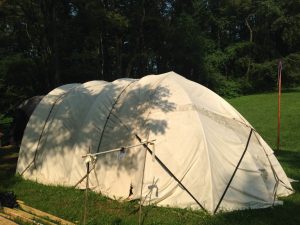 This apple-and-cheese pie comes from a 16th C. German cookbook.
This apple-and-cheese pie comes from a 16th C. German cookbook.
While apples and cheese are a classic snack pairing, their combination in this pie is pleasantly surprising. Continue reading Tortta von Epffel
 This apple-and-cheese pie comes from a 16th C. German cookbook.
This apple-and-cheese pie comes from a 16th C. German cookbook.
While apples and cheese are a classic snack pairing, their combination in this pie is pleasantly surprising. Continue reading Tortta von Epffel
 This apple-and-pear pie comes from a royal cookbook of 14th C. England.
This apple-and-pear pie comes from a royal cookbook of 14th C. England.
The use of saffron gives an interesting orange tint to the fruit. Continue reading Tartys In Applis
 This spinach quiche comes from 14th C. France, where it was included in a book instructing housewives how to maintain their residence and carry out their wifely duties. While the marital advice is no longer relevant, many of the recipes are still quite useful. Continue reading Tourte Verte
This spinach quiche comes from 14th C. France, where it was included in a book instructing housewives how to maintain their residence and carry out their wifely duties. While the marital advice is no longer relevant, many of the recipes are still quite useful. Continue reading Tourte Verte
 This sweet onion quiche comes from 14th C. England.
This sweet onion quiche comes from 14th C. England.
(Ember days were three days of penance in each quarter of the liturgical calendar during which Catholics were instructed to abstain from eating meat and devote themselves to prayer.) Continue reading Tart in Ymbre Day
 List poles provide a support for ropes used to enclose an area for medieval combat or other activities.
List poles provide a support for ropes used to enclose an area for medieval combat or other activities.
I expected I’d find existing plans I could copy for this purpose, but ended up designing my own because I couldn’t find any that fit our needs.
 This stand is designed to hold SCA youth combat “boffer” swords and similar foam-padded weapons.
This stand is designed to hold SCA youth combat “boffer” swords and similar foam-padded weapons.
I looked at a number of racks for steel and rattan weapons and then came up with a custom design that combined several elements with the following criteria.
 Editor’s Note: This writeup was originally posted to LiveJournal in 2014, and then migrated here when I set up this site. I’ve since added a few more notes and pictures.
Editor’s Note: This writeup was originally posted to LiveJournal in 2014, and then migrated here when I set up this site. I’ve since added a few more notes and pictures.
This summer we built a simple but spacious tent for use at Pennsic, an SCA medieval camping event held annually in late July near Pittsburgh.
Below I outline the historical and contemporary sources we used for the tent design, detail the materials we used, and describe the construction process we followed, with photographs of the finished result.
Our tent design choice followed from several criteria:
We settled on a “bender” design, using poles bent into an arch and half-dome, with canvas draped over them.
Although not common at SCA events, this type of tent has both an ancient history and a modern DIY tradition, outlined below. Continue reading A Bender Tent